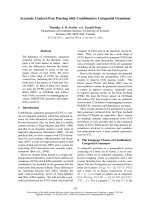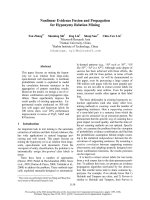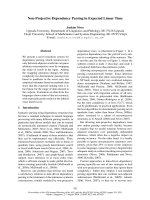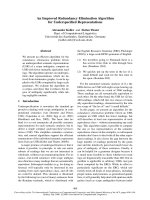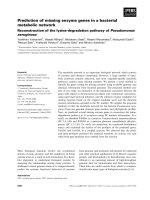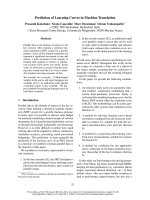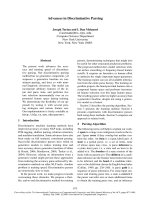Báo cáo khoa học: "Prediction in Chart Parsing Algorithms for Categorial Unification Grammar" pdf
Bạn đang xem bản rút gọn của tài liệu. Xem và tải ngay bản đầy đủ của tài liệu tại đây (547.74 KB, 6 trang )
Prediction in Chart Parsing Algorithms for
Categorial Unification Grammar
Gosse Bouma
Computational Linguistics Department
University of Groningen, P.O. box 716
NL-9700 AS Groningen, The Netherlands
e-mail:
Abstract
Natural language systems based on Categorial Unifica-
tion Grammar (CUG) have mainly employed bottom-
up parsing algorithms for processing. Conventional
prediction techniques to improve the efficiency of the
• parsing process, appear to fall short when parsing CUG.
Nevertheless, prediction seems necessary when parsing
grammars with highly ambiguous lexicons or with non-
canonical categorial rules. In this paper we present a
lexicalist prediction technique for CUG and show thai
this may lead to considerable gains in efficiency for both
bottom-up and top-down parsing.
1 Preliminaries
CATEGORIAL UNIFICATION GRAMMAR Unification-
based versions of Categorial Grammar, known as CUG
or UCG, have attracted considerable attention recently
(see, for instance, Uszkoreit, 1986, Karttunen, 1986,
Bouma, 1988, Bouma et al., 1988, and Calder et al.,
1988). The categories of Categorial Grammar (CG)
can be encoded easily as feature-structures, in which
the attribute <
cat
> dominates either an atomic value
(in case of an atomic category) or a structure with at-
tributes <
val >, < dir
> and <
arg
> (in case of
a complex category). Morphosyntactic information can
be added by introducing additional labels. An example
of such a category represented as attribute-value matrix
is presented below.
N P[+nom]/N[+nom, +sg] =
val : case : nora
dir : right
arg : case : nom
hum : sg
The combinatory rules of classical CG,
A ~ A/B B
(rightward application) and
A , B B\A
(leftward ap-
plication), can be encoded as highly schematic rewrite
rules associated with an attribute-value graph:
Rightward Application Rule :
Xo ~ XI X2
Xo:< 1>
[-
Xl : ] cat :
1.
X~ :<2>
dir : right
arg
:< 2 >
Leftward Application Rule :
X0 * X1 X2
X0:< 1>
X1 :<2>
dir : left
arg
:< 2 >
CUG is a lexicalist theory: language specific in-
formation about word order, subcategorization, agree-
ment, case-assignment, etc., is stored primarily in the
lexicon. Whereas in classical CG functor-argument
structure is the only means available for describing ling-
uistic phenomena, in CUG additional features may be
used to account for phenomena such as agreement and
case-marking (see Bouma 1988). Also, whereas in clas-
sical CG all rules are in principle universal (i.e. not
language-specific), in CUG there is a tendency to sup-
plement generic categorial rules with language or con-
struction specific rules For instance, a rule
N P ~ N [+plu]
may be added to account for the occurence of bare
plural NPs, and specific rules may be added to ac-
count for unbounded dependency constructions (Bouma
- 179 -
1987). Finally, instead of fully instantiated category-
structures, one may choose to work with polymorphic
categories (Karttunen 1989, Zeevat et al. 1987). Con-
sequently, CUG not only shows resemblances with tra-
ditional categorial grammar, but also with Head-driven
Phrase Structure Grammar (Pollard &: Sag, 1987), an-
other lexicalist and unification-based framework.
CHART PARSING OF UNIFICATION GRAMMAR
(UG). Parsing methods for context-free grammar can
be extended to unification-based grammar formalisms
(see Shieber, 1985 or Haas, 1989), and therefore they
can in principle be used to parse CUG. A chart-parser
scans a sentence from left to right, while entering
items, representing (partial) derivations, in a chart.
Assume that items are represented as Prolog terms
of the form item(Begin, End, LH S, Parsed, ToParse),
where LHS is a feature-structure and Parsed
and ToParse contain lists of feature-structures.
An item(O, 1, [S],[NP], [V, NP]) represents a partial
derivation ranging from position 0 to 1 of a constituent
with feature-structure S, of which a daughter NP has
been found and of which daughters V and NP are
still to be parsed. A word with lexical entry Word :
Cat at position Begin, leads to addition of an item
item(Begin, Begin + 1, Cat, [Word], [ ]). Next, com-
pletion and prediction steps are called until no further
items can be added to the chart.
Completion step: I For each item(B, ". E, LHS,
Parsed, [NeztlToParse]) and item(E, End, Next,
Parsed, []), add an item(B, End, LHS,
Parsed+Next, ToParse).
Bottom-up Prediction step: For each item(B, E,
Next, Parsed, [1), and each rule (LHS ~ [Next I
RHS]), add item(B, E, LHS, [Next], RHS).
The prediction step causes the algorithm to work
bottom-up.
2 The Problem
In a bottom-up chart parser, applicable rules are pre-
dicted bottom-up, and thus, lexical information is used
to constrain the addition of active items (i.e. items
representing partial derivations). At first sight, this
method appears to be ideal for CUG, as in CUG
the lexical items contain syntactic information which
is language and grammar specific, whereas the rules
are generic in nature. Note, however, that although
1 In these and following definitions, we assume, unless other-
'wise indicated, that feature-structures denoted by identical prolog
variables are unified by means of feature-unificatiom
bottom-up parsing is certainly attractive for CUG,
there are also a number of potential inefficiencies:
In many cases useless items will be predicted.
Consider, for instance, a grammar with a lexi-
con containing only the categories NP/N, N, and
NP\S, and with application as the only combina-
tory rules. When encountering a determiner, pre-
diction of an item(i,i, X, [np/n], [(np/n)\X]) is
superfluous, since there is simply no way that the
grammar could ever produce a category (np/n)\X
2
If the lexicon is highly ambiguous, many useless
(partial) derivations may take place. Consider,
for instance, the syntax of NPs in German, where
determiners and adjectives are ambiguous with
respect to case, declension pattern, gender and
number (see Zwicky, 1986, for an analysis in terms
of GPSG). The sentence die junge Frau schldfl has
only one derivation, but a bottom-up parser has to
consider 11 possible analyses for the word junge,
6 for the phrase junge Frau, 4 for die and 2 for
die junge Frau. This example shows that even irk
a pure categorial system, there may be situations
where top-down prediction has its merits.
If the grammar contains language or construction
specific rules, bottom-up prediction may be less
efficient. Relevant examples are the rule for form.
ing bare plurals mentioned irk tile previous section
and rules which implement a categorial version of
gap-threading (see Pereira & Shieber, 1986 : ll4
if). The rule shemata below allow for the deriva-
tion of sentences with a preposed element and for
the extraction of arguments:
Gap-elimination: S * X S[gap : X]
Gap-introduction: X[gap : Y] ~ X/Y
X[gap : Y] * Y\X
Oap-introduction will be used every time a func-
for category is encountered. Again, some form of
top-down prediction could improve this situation.
In the following sections, we will consider top-down
parsing, as an alternative for the bottom-up approach,
and we will consider the possibility of improving the
predictive capabilities of a bottom-up parser.
~The example may suggest that prediction should be elimi-
nated
Ml together.
This option is feasible only if the rule set is
restricted to application.
- 180 -
3 Top-down Parsing
Top-down chart parsing differs from the algorithm de-
scribed above only in the prediction-step, which pre-
dicts applicable rules top-down. Contrary to bottom-
up parsing, however, the adaptation of a top-down al-
gorithm for UG requires some special care. For UGs
which lack a so-called
context-free back-bone,
such as
CUG, the top-down prediction step can only be guar-
anteed to terminate if we make use of
restriction, as
defined in Shieber (1985).
Top-down prediction with a restrictor R (where R
is a (finite) set of paths through a feature-structure)
amounts to the following:
Restriction The restriction of a feature-structure F
relative to a restrictor R is the most specific
feature-structure F ~ E_ F, such that every path
in F j has either an atomic value or is an element
of R.
Predictor Step For each
item(_ , End, LHS, Parsed,
[Next I ToParse])
such that
Rjve~,
is the re-
striction of
Next
relative to R, and each rule
RNe~:t ~ RHS,
add
item(i,i, Rge~:t, [], RHS).
Restriction can be used to develop a top-down chart
parser for CUG in which the (top-down) prediction step
terminates. The result is unsatisfactory, however, for
the following two reasons. First, as a consequence of
the generic and language independent nature of cate-
gorial rules, the role of top-down prediction as a con-
straint on possible derivation steps is lost completely.
Second, many useless items will be predicted due to
the fact that the
LHS
of both rightward and leftward
application always match with
RJvext
in the:prediction
step (note that a bottom-up parser has a similar inef-
ficiency for leftward application only). Therefore, the
overhead which is introduced by top-down prediction
does not pay-off. We conclude that, eventhough the in-
troduction of restriction make it possible to parse CUG
top-down, in practice, such a method has no advantages
over a bottom-up approach.
4 Lexicalist Prediction
Instead of customizing existing top-down parsing algo-
rithms for CUG, we can also try to take the opposite
track. That is, we will try to represent a CUG in such
a way that non-trivial forms of top-down prediction are
possible.
Top-down prediction, as described in the previous
section, relies wholly on the syntactic information en-
coded in the syntactic rules. For CUG, this is an akward
situation, as most syntactic information which could be
relevant for top-down prediction is located in the lexi-
con. tn order to make this information accessible to the
parser, we precompile the grammatical rules into a set
of
instantiated rules.
The instantiated rules are more re-
strictive than the generic categorial rules, as they take
lexical information into account.
The following algorithm computes a set of instanti-
ated syntactic rules, given a set of generic rules and a
lexicon.
Compilation For every category C, where C is either
a lexical category or the
LHS
of an instantiated
rule, and every (generic) rule
GR,
if C is utlifiable
with the head-daughter of
GR,
add
GR'
(the re-
sult of the unification) to the set of instantiated
rules, a
We assume that there is some way of distinguishing
head-daughters from non-head daughters (for instance,
by means of a feature). The head daughter should be
the daughter which has the most ialluellce on the in-
stantiation of the rule. For the application rules, for
instance, the functor is the most natural choice, as the
functor both determines the instantiation of the resul-
tant category and of the argument category.
The compilation step is correct and complete for
arbitrary UGs, that is, a string is derivable using the
instantiated rules if and only if it is derivable using
the generic rules. Note, however, that the compila-
tion procedure does not necessarily terminate. Con-
sider for instance a categorial gramrnar with category
raising
(X/(Y\X) , Y).
In such a gramrnar, arbitrar-
ily complex instantiations of this rule can be compiled.
To avoid the creation of an infinite set of rules, we may
again employ restriction:
Compilation with restriction Let R be a restrictor.
For every category C, where C is either a lexical
category or the
LHS
of art instantiated rule, and
every (generic) rule
GR,
if the restriction of C
relative to R is unifiable with the head-daughter
of
GR,
add
GR ~
(the result of the unification) to
the set of instantiated rules.
The compilation step is guaranteed to terminate a.s
long as R is finite (cf. Shieber, 1985). The compi-
lation procedure is not specific to a certain grammar
formalism or rule set, and thus can be used to compile
arbitrary UGs. Such a compilation step will give rise
to a substantially more instantiated rule set in all cases
3Note that for classical CG, an algorithm of this kind can
be used to compute the phrase-structure eqtfivalent of the input
granunax.
181 -
where schematic grammar rules are used in combination
with highly structured lexical items.
For the compiled grammar, a standard top-down al-
gorithm (such as the one in section 3) can be used. Pre-
diction for CUG is now significant, as only rules which
have a functor category that is actually derivable by the
grammar will be predicted. So, starting from a category
S, we will not predict leftmost categories such as
S/NP,
(S/NP)/NP,
if no such categories can be derived from
the lexical categories. Also, a leftmost argument cate-
gory A will only be predicted if the grammar contains
a matching functor category
A~S.
Finally, since we are
working with the instantiated rules, morphosyntactic
information can effectively be predicted top-down.
Restriction is not only useful to guarantee termi-
nation of the compilation procedure. The precompi-
lation procedure can in principle lead to an instanti-
ated grammar that is considerably larger than the input
grammar. For instance, given a grammar which distin-
guishes between plural and singular and between first,
second and third person NPs, six versions of the rule
S ~ NP NP\S
might be derivable. Such a multipli-
cation is unnecessary, however, as it does not provide
any information which is useful for the top-down pre-
diction step. Choosing a restrictor which filters out all
distinctions that are irrelevant to top-down prediction,
can prevent an explosion of the rule set.
5 Bottom-Up Parsing with Pre-
diction
The compilation procedure described in section 4 was
developed to improve the performance of top-down
parsing-algorithms for lexicalist grammars of the CUG-
variety. In this section, we argue that replacing a
generic CUG with its instantiated.equivalent also has
advantages for bottom-up parsing. There are two rea-
sons to believe that this is so: first, predictions based on
leftward application will be less frequent and second, to
an instantiated grammar non-trivial forms of top-down
prediction can be added.
In section 2 we pointed out that a bottom-up parser
will predict many useless instances of leftward applica-
tion. This is due to the fact that the leftmost daughter
of leftward application is completely general and thus,
given an
item(B, E, Cat, Parsed, I]),
an
item(B,E, X,
[Cat], [Cat\X])
will always be predicted. The compi-
lation procedure presented in the previous section re-
places leftward application with instantiated versions
of this rule, in which the leftmost argument of the rule
is instantiated. Although the instantiated rule set of a
grammar is bound to be larger than the original rule
set, which is a potential disadvantage, the chart will
grow less fast if we use theinstantiated grammar. It is
therefore worthwhile to investigate the performance of
a bottom-up parser which uses a compiled grammar as
opposed to a bottom-up parser working with a generic
rule set.
There is a Second reason for considering instan-
tiated grammars. It is possible in bottom-up pars-
ing to speed up the parsing process by adding top-
down prediction. Top-down prediction is implemented
with the help of a table containing items of the
form
left_corner(Ancestor, LeftCorner),
which lists
the
left-corner
relation for the grammar at hand. The
left-corner
relation is defined as follows:
Left-corner Category C1 is a left-corner of an ancestor
category A if there is a rule A * C1 C,. The
relation is,transitive: if A is a left-corner of B and
B a left-corner of C, A is a left-corner of C.
Top-down filtering is now achieved by modifying the
prediction step as follows :
Bottom-up Prediction with Top-down Filtering:
For each
item(B, E, Cat, Parsed, []),
and each
rule
(Xo "-* [Cat [ RHS]),
such that there is an
item(_, B, _, _, [NeztlToParse])
with Xo a left-
corner of
Next,
add
item(B, E, Xo, [Cat], RHS) 4.
For CUG it makes little sense to compute a left-
corner relation according to this definition, since any
category X is a left-corner of any category Y (accord-
ing to leftward application), and thus the left-corner
relation can never have any predictive power.
For an instantiated grammar, the situation is more
promising. For instance, given the fact that only nom-
irmtive NPs occur as left-corner of S, and that every
determiner which is the left-corner of NP, has a case
feature which is compatible (unifiable) with that NP, it
can be concluded that only nominative determiners can
be left-corners of S.
Computing the left-corner relation mechanichally
for a UG will not always lead to the most economic-
a| representation of the left-corner table. For exam-
pie, in German the left-corner of an NP with case and
number features X will be a determiner with identi:
cal features. If we compute this, using a sufficiently
4The bottom-up parsing algorithm extended with left-corner
prediction is closely
related to
the
BUP-parser
of Matsumoto et
al. (1983). The
BUP-parser
is based on definite clause grammar
and thus, may backtrack. Minimal use is made of a chart (in
which successful and failed
parse attempts are
stored). Our algo-
rithm assigns a more important role to the chart and thus
avoids
backtracking.
182 -
instantiated grammar, we get 8 versions (i.e. 4 cases
times 2 possible values for number) of this relation.
Similar observations can be made for adjectives that
are left-corners of N (where things are even worse, as
we would like to take declension classes into account
as well). This multiplication may lead to a needlessly
large left-corner table, which, if used in the prediction
step, may in fact lead to sharp decreases in parsing per-
formanee (see also Haas, 1989, who encountered sim-
ilar problems). Note that checking a left-corner table
containing feature-structures is in general expensive, as
unification, rather than identity-tests, have to be car-
ried out.
To avoid tMs problem we have found it necessary to
construct the left-corner table by hand, using linguistic
meta.knowledge
about what is relevant, given a particu-
lar left-corner relation, to top-down prediction to com-
press the table to an absolute minimum. It turns out to
be the case that only in this way the effect of top-down
filtering will pay-off against the increased overhead of
having to check the left-corner table.
6 Some Results
The performance of the parsing algorithms discussed
in the preceding sections (a bottom-up parser for UG
(BU), a top-down parser for UG (of Shieber, 1985)
(TD), a top-down parser operating on an instantiated
grammar (TD/1), and a bottom-up parser with top-
down filtering operating on an instantiated grammar
(BU/LC)) were tested on two experimental CUGs, one
implementing the morphosyntactic features of German
N Ps, and one implementing the syntax of WH-questions
in Dutch by means of a gap-threading mechanism.
Some illustrative results are listed in Tables 1 and 2.
Sentencel Sentence2
items sees items sees
TD: 93 5.9 160 10.5
TD/I: 45 2.0 68 2.5
BU: 68 2.0 120 3.0
Bu/ c: 12 o.6 53 o.9
Table1: German
For German, an ideal restrictor R was {< l* > II =
cat,val, arg,
or
dir}.
This restrictor effectively filters
out all morphosyntactic information, in as far as it is not
repeated in the categorial rules. The resulting precom-
piled grammar is much smaller than in the case where
no restriction was used or where morphosyntactic in-
formation was not completely filtered out. A categorial
lexicon for German, for instance, containing only deter-
miners, adjectives, nouns, and transitive and intransi-
tive verbs, will give rise to more than 60 instantiated
rules if precompiled without restriction, whereas only
four rules are computed if R is used (i.e. only two more
than in the uncompiled (categorial) grammar). The
improvement in efficiency of TD/I over TD is due to
the fact that no useless instances of leftward applica-
tion are predicted and to the fact that no restriction is
needed during parsing with an instantiated grammar.
Thus, prediction based on already processed material
can be maximal. As soon as we have parsed a cate-
gory
N P/N[+sg, +wk, +dat, +fern],
for instance, top-
down prediction will add only those items that have
N[+sg, +wk, +dat, +fern] as LHS.
BU is almost, as efficient as TD/I, eventhough it
works with a generic grammar, and thus produces
(significantly) more chart-items. Once we replace the
generic grammar by an instantiated grammar, and add
left-corner relationships (BU/LC), the predictive capac-
ities of the parser are maximal, and a sharp decrease in
the number of chart items and parse times occurs.
Senteneel Sentence2 Sentence3
items sees items sees items sees
TD: 255 32.2 225 27.9 358 47.2
TD/I: 48 3.2 71 6.0 ]29 11.9
BU : 78 1.8 74 1.7 131 3.6
BU/LC: 40 1.7 45 2.1 ~i9 3.9
Tablel:
Gap-threading
For the grammar with gap-threading (table 2),
we used a restrictor R = {< 1 ° > II =
eat,val, arg,dir, gap, in
or
out}.
The TD parser en-
counters serious difficulties in this case, whereas TD/I
performs significantly better, but still is rather ineffi-
cient. There is a distinct difference between BU and
BU/LC if we look at the number of chart items, al-
though the difference is less marked than in the case of
German. In terms of parse times the two algorithms
are almost equivalent.
Comparing our results with those of Shieber (1985)
and Haas (1989), we see that in all cases top-down fil-
tering may reduce the size of the chart significantly.
Whereas Haas (1989) found that top-down filtering
never helps to actually decrease parse times in a
bottom-up parser, we have found at least one example
(German) where top-down filtering is useful.
- 183 -
7 Conclusions
There is a trend in modern linguistics to replace gram-
mars that are completely language specific by grammars
which combine universal rules and principles with lan-
guage specific parameter settings, lexicons, etc. This
trend can be observed in such diverse frameworks
as Lexical Functional Grammar, Government-Binding
Theory, Head-driven Phrase Structure Grammar and
Categorial Grammar. In parsing with such formalisms,
especially those formalisms that are unification-based,
we find that traditional parsing-techniques, eventhough
they may be applicable to UG, are no longer satisfac-
tory. In particular, prediction techniques which may
be efficient for phrase structure grammar do not always
carry over easily to UG. The present paper shows that if
a grammar uses only schematic combinatory principles
instead of phrase-structure rules, prediction is only pos-
sible if we replace the generic rules by grammar-specific
instances of these rules.
8 Literature
Bourns, G. 1987. A Unification-based Analysis of Un-
bounded Dependencies in Categorial Grammar, in J.
Groenendijk, M. Stokhof, & F. Veltman (eds.) Proceed-
ings of the sixth Amsterdam Colloquium, University of
Amsterdam, Amsterdam, 1-19.
Bourns, G., 1988, Modifiers and Specifiers in Categorial
Unification Grammar, Linguistics, vol 26, 21-46.
Bourns, G., E. KSnig, & H. Uszkoreit, 1988. A Flexi-
ble Graph-Unification Formalism and its Application to
Natural Language Processing, IBM Journal of Research
and Development, 32, 170-184.
Calder, J., E. Klein, & H. Zeevat 1988. Unification
Categoriai Grammar: a concise, extendable grammar
for natural language processing. Proceedings of Coling
1988, Hungarian Academy of Sciences, Budapest, 83-
86.
Haas, A. 1989. A Parsing Algorithm for Unification
Grammar. Computational Linguistics 15-4, 219-232.
Karttunen, L. 1989. Radical Lexicalism. In M. Baltin
& A. Kroch (eds.), Alternative Conceptions of Phrase
Structure, Chicago University Press, Chicago, 43-66.
Matsumoto, Y., H. Tanaka, H. Hirakawa, II. Miyoshi,
& H. Yasukawa, 1983, BUP : A Bottom-Up Parser em-
bedded in Prolog. New Generation Computing, vol 1,
145-158.
Pereira, F., & S. Shieber (1986). Proiog and Natural
Language Analysis. CSLI Lecture Notes 10, University
of Chicago Press, Chicago.
Pollard, C. • I. Sag, 1987, Information-Based Syntax
and Semantics, vol 1 : Fundamentals, CSLI Lecture
Notes 13, University of Chicago Press, Chicago.
Shieber, S. 1985. Using Restriction to Extend Pars-
ing Algorithms for Complex-Feature-Based Algorithms.
Proceedings of the g2nd Annual Meeting of the As-
sociation for Computational Linguistics, University of
Chicago, Chicago, 145-152.
Uszkoreit, H. 1986. Categorial Unification Grammars.
Proceedings of COLING 1985. Institut fiir angewandte
Kommunikations- und Sprachforschung, Bonn, 187-194.
Zeevat, H., E. Klein, & J. Calder, 1987. An Introduc-
tion to Unification Categorial Grammar. In N. Had-
dock, E. Klein, & G. Morill (eds.), Categorial Grammar,
Unification grammar, and Parsing, Edinburgh Working
Papers in Cognitive Science, Vol. 1.
Zwicky, A. 1986. German Adjective Agreement in
GPSG. Linguistics, vol 24,957-990.
- 184 :

